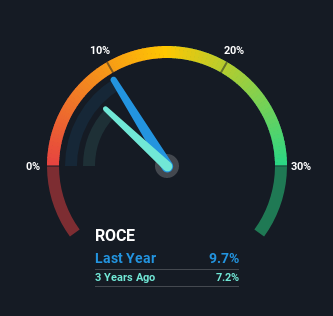- South Korea
- /
- Basic Materials
- /
- KOSE:A004090
Korea Petroleum Industries (KRX:004090) Could Be At Risk Of Shrinking As A Company
If you're looking at a mature business that's past the growth phase, what are some of the underlying trends that pop up? Businesses in decline often have two underlying trends, firstly, a declining return on capital employed (ROCE) and a declining base of capital employed. This indicates the company is producing less profit from its investments and its total assets are decreasing. Having said that, after a brief look, Korea Petroleum Industries (KRX:004090) we aren't filled with optimism, but let's investigate further.
Understanding Return On Capital Employed (ROCE)
For those that aren't sure what ROCE is, it measures the amount of pre-tax profits a company can generate from the capital employed in its business. To calculate this metric for Korea Petroleum Industries, this is the formula:
Return on Capital Employed = Earnings Before Interest and Tax (EBIT) ÷ (Total Assets - Current Liabilities)
0.097 = ₩17b ÷ (₩316b - ₩139b) (Based on the trailing twelve months to December 2020).
Therefore, Korea Petroleum Industries has an ROCE of 9.7%. On its own that's a low return, but compared to the average of 4.5% generated by the Basic Materials industry, it's much better.
View our latest analysis for Korea Petroleum Industries

Historical performance is a great place to start when researching a stock so above you can see the gauge for Korea Petroleum Industries' ROCE against it's prior returns. If you want to delve into the historical earnings, revenue and cash flow of Korea Petroleum Industries, check out these free graphs here.
What Can We Tell From Korea Petroleum Industries' ROCE Trend?
We are a bit worried about the trend of returns on capital at Korea Petroleum Industries. About five years ago, returns on capital were 12%, however they're now substantially lower than that as we saw above. And on the capital employed front, the business is utilizing roughly the same amount of capital as it was back then. This combination can be indicative of a mature business that still has areas to deploy capital, but the returns received aren't as high due potentially to new competition or smaller margins. So because these trends aren't typically conducive to creating a multi-bagger, we wouldn't hold our breath on Korea Petroleum Industries becoming one if things continue as they have.
On a side note, Korea Petroleum Industries' current liabilities are still rather high at 44% of total assets. This effectively means that suppliers (or short-term creditors) are funding a large portion of the business, so just be aware that this can introduce some elements of risk. While it's not necessarily a bad thing, it can be beneficial if this ratio is lower.
Our Take On Korea Petroleum Industries' ROCE
In summary, it's unfortunate that Korea Petroleum Industries is generating lower returns from the same amount of capital. The market must be rosy on the stock's future because even though the underlying trends aren't too encouraging, the stock has soared 254%. In any case, the current underlying trends don't bode well for long term performance so unless they reverse, we'd start looking elsewhere.
One final note, you should learn about the 3 warning signs we've spotted with Korea Petroleum Industries (including 2 which are significant) .
If you want to search for solid companies with great earnings, check out this free list of companies with good balance sheets and impressive returns on equity.
When trading Korea Petroleum Industries or any other investment, use the platform considered by many to be the Professional's Gateway to the Worlds Market, Interactive Brokers. You get the lowest-cost* trading on stocks, options, futures, forex, bonds and funds worldwide from a single integrated account. Promoted
Valuation is complex, but we're here to simplify it.
Discover if Korea Petroleum Industries might be undervalued or overvalued with our detailed analysis, featuring fair value estimates, potential risks, dividends, insider trades, and its financial condition.
Access Free AnalysisThis article by Simply Wall St is general in nature. It does not constitute a recommendation to buy or sell any stock, and does not take account of your objectives, or your financial situation. We aim to bring you long-term focused analysis driven by fundamental data. Note that our analysis may not factor in the latest price-sensitive company announcements or qualitative material. Simply Wall St has no position in any stocks mentioned.
*Interactive Brokers Rated Lowest Cost Broker by StockBrokers.com Annual Online Review 2020
Have feedback on this article? Concerned about the content? Get in touch with us directly. Alternatively, email editorial-team (at) simplywallst.com.
About KOSE:A004090
Korea Petroleum Industries
Manufactures and sells asphalt, solvents, and building materials in South Korea and internationally.
Adequate balance sheet with low risk.
Market Insights
Community Narratives



